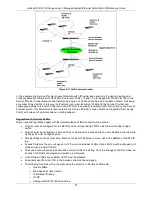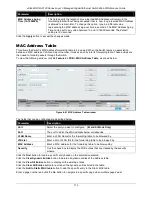
xStack® DGS-3120 Series Layer 3 Managed Gigabit Ethernet Switch Web UI Reference Guide
100
Figure 4-34 Layer 2 Protocol Tunneling Settings window
The fields that can be configured are described below:
Parameter
Description
Layer 2 Protocol
Tunneling State
Click to enable or disable the Layer 2 protocol tunneling state.
Unit
Specify the unit ID to be configured.
(EI and SI Mode Only)
From Port / To Port
Use the drop-down menus to select a range of ports to use in the configuration.
Type
Specify the type of the ports.
UNI
- Specify the ports as UNI ports.
NNI
- Specify the ports as NNI ports.
None
- Disable tunnel on it.
Tunneled Protocol
Specify tunneled protocols on the UNI ports.
STP
- Specify to use the STP protocol.
GVRP
- Specify to use the GVRP protocol.
Protocol MAC
- Specify the destination MAC address of the L2 protocol packets that will
tunneled on these UNI ports. The MAC address can be 01-00-0C-CC-CC-CC or 01-00-
0C-CC-CC-CD.
All
- All tunnel enabled Layer 2 protocols will be tunneled on the ports.
Threshold (0-
65535)
Specify the drop threshold for packets-per-second accepted on the UNI ports. The ports
drop the PDU if the protocol’s threshold is exceeded.
Click the
Apply
button to accept the changes made for each individual section.
Enter a page number and click the
Go
button to navigate to a specific page when multiple pages exist.
Spanning Tree
This Switch supports three versions of the Spanning Tree Protocol: 802.1D-1998 STP, 802.1D-2004 Rapid STP,
and 802.1Q-2005 MSTP. 802.1D-1998 STP will be familiar to most networking professionals. However, since
802.1D-2004 RSTP and 802.1Q-2005 MSTP have been recently introduced to D-Link managed Ethernet switches,
a brief introduction to the technology is provided below followed by a description of how to set up 802.1D-1998 STP,
802.1D-2004 RSTP, and 802.1Q-2005 MSTP.
802.1Q-2005 MSTP
Multiple Spanning Tree Protocol, or MSTP, is a standard defined by the IEEE community that allows multiple
VLANs to be mapped to a single spanning tree instance, which will provide multiple pathways across the network.
Therefore, these MSTP configurations will balance the traffic load, preventing wide scale disruptions when a single
spanning tree instance fails. This will allow for faster convergences of new topologies for the failed instance.
Frames designated for these VLANs will be processed quickly and completely throughout interconnected bridges
utilizing any of the three spanning tree protocols (STP, RSTP or MSTP).
Summary of Contents for xStack DGS-3120 Series
Page 1: ......
















































